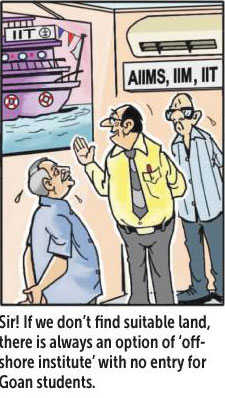
Sujay Gupta
There is a phrase in the lexicon of babudom which may seem innocuous but is perhaps the most powerful tool appropriated by elected governments. It is called ‘Competent Authority’. Beyond the wood-panelled corridors of government, away from the silence and in a world removed from this so-called finesse, the phrase may well be replaced by this- ‘dadagiri’.
If you look at both phrases from two apparently different worlds, you may be forgiven if you wonder if they are actually similar - ‘Competent Authority’ & ‘dadagiri’.
Let us put this into context. There is a justifiable furore over the manner in which the State Wildlife Board recommended the clearing of three contentious projects, the railway double tracking from Hospet fo Vasco, the 400 kV High Transmission Line and the four-laning of the National Highway.
The Chief Wildlife Warden of Goa Santosh Kumar speaking on camera to the Living Heritage Foundation, which has, and is supported by, conservationists, environmentalists, filmmakers and others with impeccable credentials of being earth warriors, appeared a tad irritated when pressed about how he of all people could back projects which required so much of diversion of forest land for non-forest activities. His response shattered some myths about his own role. He said "that just because there is a wildlife sanctuary, it doesn’t mean other activities cannot be allowed”. He may have a case if you go by minute technicalities but the truth is that any such deviations are governed by very tough rules. And these rules can either be followed or bent or broken by the all-powerful ‘Competent Authority’ which is the government. The ‘Authority’ brooks no opposition. It allows a democratic process, only as a pure lip-service and then the “Authority” exercises its authority. It does what it wants.
If there were any lingering doubts about this, let us draw attention to the same Chief Wildlife Warden’s comment to The Indian Express in a piece by Smita Nair published on June 3. Responding to allegations that noted private citizens on the State Wildlife Board were hoodwinked and the projects cleared at a meeting of the board on December 2, 2019, without any discussion or forewarning, Santosh Kumar was quoted as having said, “They raised many issues, and the project proponents, the authorities from national highways and railways and whosoever was there, explained to them and accordingly, a decision was taken by the Chief Minister who is also the chairperson of the Board… There is no provision in the law that says a development project has to be done by plebiscite. It has to be done by the competent authority.”
Let the jury be out. In any case the Central Empowered Committee of the Supreme Court is monitoring these approvals and the High Court is hearing a PIL moved by the Goa Foundation led by Champion environmentalist Claude Alvares and has sought affidavits in reply from the government and its bodies. While that will be settled, isn’t it fair to ask if the appropriation of supreme powers by the ‘Competent Authority’, (as borne by Santosh Kumar’s reported statement) and an act of ‘dadagiri’ are really far removed from each other. After all ‘dadagiri’ can pass off as an acronym for ‘might is right’ or as the Hindi proverb goes ‘jiski lathi uski bhains’ (he who wields the stick is the owner of the buffalo). And bodies ranging from khap panchayats to kangaroo courts, use dadagiri as the leitmotif of their authority. Their competent authority.
The issue at hand is grave. The standard justification given by the state and central governments is that the State Wildlife Board has given assent for the clearance of the three projects at hand. But that isn’t quite what happened. In that meeting held at Chief Minister Pramod Sawant’s residence on December 2 2019, the board was called by Sawant who is the Chairperson. The board also has independent experts, (Environmentalists, wildlife activists, NGOs). Six members of this wildlife panel including noted environmentalist Rajendra Kerker said that the clearance which is being flashed in their name, was shocking since they did not quite give their green nod to these projects and have stated that the mitigation measures to balance environmental damage are unscientific.
The threat to biodiversity is very real according to them. Importantly, three environmentalists and NGOs have written the Chief Wildlife Warden stating “on the way the meeting (of Dec 2, 2019) was conducted with hardly any formal structured discussion or debate on serious issues”. (Quote sourced from the Express report, also used as documentation in the PIL in the High Court by Goa Foundation).
The narrative here needs to be underlined and explained. While there can be a debate on the merits of the opposition to the three projects, there can be no debate on taking people for granted, throwing the might of the ‘Competent Authority’ on the faces of people and most importantly, bypassing, ignoring or undervaluing basic protections given to wildlife and forests by acts under the same constitution that competent authorities swear by.
Let’s cut to the chase. The opposition is not to projects which are development-oriented in the true sense. It is to destroying the value of wildlife and forests, and this value is both tangible and intangible, and replacing it with projects whose value is tangible only to limited beneficiaries. It is this math which is not adding up. The math of taking from mother earth, its people and creatures, and placing all of it at the altar of projects whose sole benefit seems to be to aid transportation of massive amounts of coal across the state.
Is that all Goa is reduced to? As a passage for vested interests?
But there is hope in times of despair. Thankfully the reservoir of credibility in Goa is big and there are passionate talents that come to the fore. There are discussions, and now there is a forthcoming documentary film made by Marc Francis of the Living Heritage Foundation, (in which Santosh Kumar has been interviewed) based on extensive filming in Mollem and other areas threatened by these projects. The film will bring to you sights, sounds, voices of not just people but of the creatures of nature in action. Like a bird that gently glides over a sanctuary of the forest and gets a birds-eye view of the initial stages of destruction, the truth is really laid bare for sensitive eyes to fathom.
As Parag Rangnekar of the Goa Bird Conservation Network says in the documentary “It’s all about what our future lifestyles need to be, the need to un-build, dismantle a lot of structures and go back to a simpler life”.
Contrary to what the Chief Wildlife Warden of the State feels in that film when he says that the expanded four-lane highway which will cut through the Western Ghats will be a “tourist attraction”, Goa’s preservation is in the hands of real people with real feelings and knowledge about what Goa needs.
In addition to obvious frontline heroes like Claude Alvares, we need to identify other heroes doing what they do in their forests and villages. Like Nestor Rangel who has brought 500 families together in St Estevam to convert fallow land into productive fields. Or Pranoy Baidya of the Zoology department of the Government College of Sankhali who has discovered a new ant species in the Netravali wildlife sanctuary and named it after his Head of Department and mentor Professor Vaibhav
Chindarkar calling the species Vaibhav’s Protanilla. Chindarkar has personally groomed a generation of wildlifers in Goa. Or take Alex Carpenter, snake catcher and wildlife rescuer who has developed an ecosystem of sustainable living in the Agonda area of deep South Goa. And there are so many others who expand this humanitarian and selfless work, giving all of us hope and inspiration.That fact that they are competent is settled. We now need to collectively stand together to make sure that they and we become the “Authority”.
The authority of people, who will not be taken for granted and not hoodwinked.
Sujay Gupta is the Consulting Editor Herald Publications and tweets @sujaygupta0832
